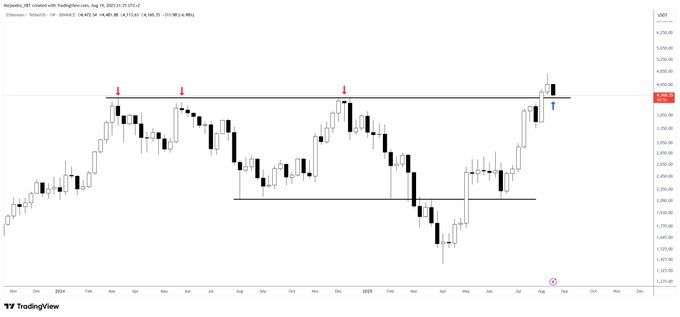Ethereum retests $4,100 as support after breaking above it; this retest confirms a resistance-to-support flip and signals a consolidation phase for ETH. Traders watch $4,080 downside support and $4,300 resistance for the next directional move, with liquidity and volume remaining healthy.
-
Ethereum retests $4,100 — formerly long-term resistance — now acting as key support.
-
Trading volume rose ~2% to $48.84B while market cap sits near $504.61B, showing sustained liquidity.
-
Immediate levels: downside support $4,080; resistance $4,300; extended targets $4,800–$5,000 if momentum resumes.
Ethereum retests $4,100 — ETH consolidation at $4,100 support; monitor volume, $4,080 downside, and $4,300 resistance for trade setups. Read analysis and next steps.
What is happening as Ethereum retests $4,100?
Ethereum retests $4,100 after moving above this historical resistance, evaluating whether the zone will hold as support. The retest indicates consolidation: traders watch $4,080 as immediate downside support and $4,300 as the next resistance that must be reclaimed for bullish continuation.
How does the $4,100 retest affect ETH price structure?
Price structure shows a resistance-to-support flip at $4,100, a classic technical event that often precedes directional continuation. Short-term charts indicate a pullback to $4,080 before a rebound; failure below $4,080 would expose support near $3,900–$4,000.
Ethereum trades around $4,180 as $4,100 is retested as support. Traders watch this critical level for potential bullish continuation.
- Ethereum retests $4,100 after years of resistance, confirming a potential resistance-to-support flip.
- Trading volume rose 2% despite a 1.39% daily decline, reflecting continued market participation.
- ETH remains in consolidation, with $4,080 as key downside support and $4,300 as immediate resistance.
Ethereum forms a critical stage of retesting the $4,100 zone that was formerly a long-term resistance corridor. This level is carefully watched by the market to determine whether it can sustain as support and act as the base for a bullish resumption.
$4,100 as a Historic Level
Ethereum’s $4,100 level has carried historical weight. As observed by market analyst Alejandro₿TC, ETH faced repeated rejections here in 2021 and 2022. Each attempt to break through resulted in notable sell-offs, cementing this price as a decisive psychological barrier.

Source: Alejandro₿TC,
In 2025, the situation is markedly different. ETH has moved above this zone and is now retesting it from above. Traders recognize this as a support flip, a common structural event that can precede further upward movement when confirmed by volume and follow-through.
The latest chart shows ETH pulling back to this zone, marked by a blue arrow on trader charts. The outcome of this retest will determine whether buyers maintain control or whether price risks slipping below again, which would invalidate the bullish flip.
Market Performance and Liquidity
As of the time of writing, Ethereum market capitalization is approximately $504.61 billion. ETH recorded a 1.39% decline over the last 24 hours, remaining the second-largest cryptocurrency by market cap.

Source: coinmarketcap
Average daily trading volume rose roughly 2% to $48.84 billion, keeping the Volume-to-Market-Cap ratio near 9.89. High liquidity supports smoother execution and indicates continued market participation even during consolidation.
Circulating supply stands around 120.7 million ETH. The Ethereum burn mechanism (EIP-1559) reduces net issuance during periods of high activity, exerting a mild deflationary pressure when on-chain demand increases — a structural element supporting ETH’s monetary narrative.
Technical Structure and Next Levels
Technically, Ethereum is in an accumulation/consolidation phase after earlier drawdowns into the $2,200–$2,400 range. The $4,100–$4,200 zone is the immediate pivot for near-term directional bias.
Short-term action: ETH opened above $4,235, pulled back to ~ $4,080, then stabilized near current levels. A decisive close above $4,250 would signal renewed buyer conviction. Conversely, a sustained break below $4,080 could lead to a test of $3,900–$4,000 support.
Upside targets on a confirmed bullish continuation: $4,300 first, then the $4,800–$5,000 zone if momentum and volume increase. Monitor on-chain activity and exchange flows for confirmation.
Frequently Asked Questions
Will the $4,100 retest turn into sustained support for ETH?
Yes, if buyers defend the $4,080–$4,100 area with rising volume and price closes above $4,250, the retest is likely validated and can act as a springboard toward $4,300–$4,800. Lack of buying pressure risks deeper pullbacks.
How should traders manage risk around this retest?
Use tight position sizing, set stop-losses below $4,080 for long trades, and watch volume for confirmation. Consider scaling entries and hedging if ETH shows extended weakness beneath $4,000.
Key Takeaways
- Resistance-to-support flip: $4,100 is being retested as support after past rejections.
- Liquidity intact: Volume rose ~2% and market cap remains robust, supporting trade execution.
- Watch levels: $4,080 downside support; $4,300 resistance; $4,800–$5,000 as extended upside targets.
Conclusion
Ethereum retesting $4,100 is a pivotal technical event that places ETH in a consolidation phase with clearly defined risk and reward levels. Traders should front-load on-chain and volume signals, respect $4,080 as the key stop-loss threshold, and monitor $4,300 for confirmation of bullish continuation. COINOTAG will continue to update this analysis as new data emerges.
